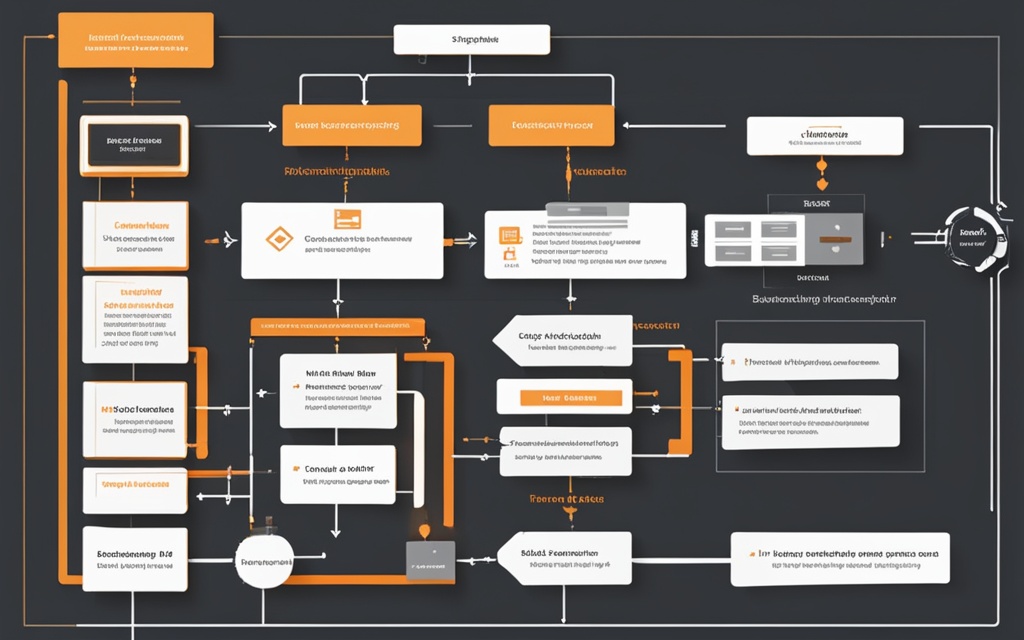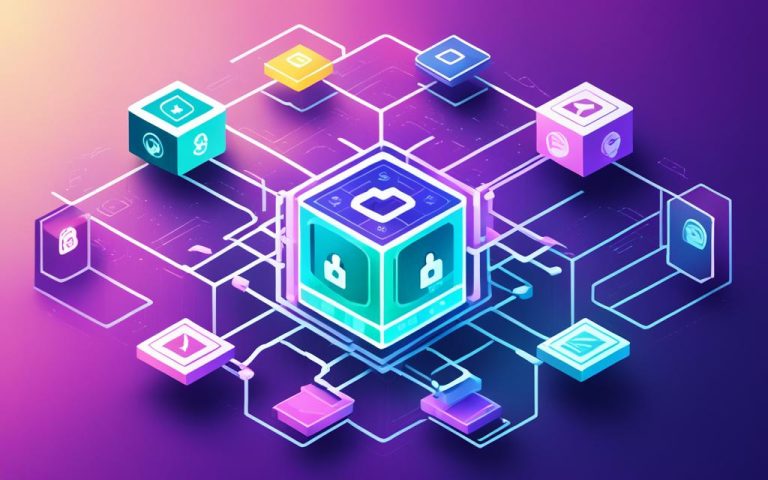Creating your own blockchain involves several steps. First, create a block. Then, add data to this block.
Next, you hash the block. Finally, you chain the blocks together.
To build blockchain prototypes, people often use programming languages. They might choose Golang, JavaScript, Go, or Python. Knowledge in blockchain basics like cryptography is crucial.
Also, understanding decentralized systems and data structures is necessary.
Before starting, make sure you know what’s needed. This includes having a network and understanding programming. These are essential for blockchain creation.
Understanding Blockchain and Its Functionality
Blockchain is a game-changing technology that’s drawing broad interest for its openness, safety, and decentralized nature. To get how blockchain functions,
it’s vital to understand the idea behind it and its key operations.
Put simply, blockchain is a spread-out database and network that keeps and checks digital deals. It’s like a chain of blocks. Each block stores important info including transaction data, time stamps, and more. The blocks are securely linked together, making an unchangeable record that’s safe from meddling. This secures the data’s honesty and keeps it untouched.
But, what makes blockchain tick? At its core, it’s powered by a network of computers, named nodes, that work together. Every node has the full blockchain, which helps keep the data uniform and truthful across the network. This way, there’s no need for a central authority, boosting safety against harmful attacks.
A crucial part of blockchain is its consensus algorithm. This system makes sure all the network’s nodes agree on the validness of transactions. Using different consensus algorithms, like Proof of Work (PoW) and Proof of Stake (PoS), helps reach this agreement.
Moreover, blockchain uses crypto hashing and digital signatures to protect and sign-off on data. Each block has a unique hash, made by applying crypto functions to the block’s info. Changing the block alters its hash, which signals tampering. This adds another layer of security.
Blockchain offers vast benefits across industries by cutting out middlemen, reducing costs, and improving transparency and data history. It’s perfect for needs like auditing and accountability. Blockchain’s applications, from supply chains and health records to financial operations and voting, are revolutionizing industries.
Blockchain in Action: A Real-World Example
Let’s look at a real example: Bitcoin. Bitcoin is a digital currency running on blockchain. Every Bitcoin deal is recorded on the blockchain and is open for public checking. This transparency protects transactions from fraud.
When a Bitcoin transaction starts, it’s sent to the network and grouped in a block. Miners, special network nodes, work to prove the transactions and add the block to the blockchain. Once added, the transaction is permanent and unchangeable.
The decentralization and strong security of blockchain create a reliable environment. It lets people make transactions without middlemen. This gives them control over their data and enables safe, global peer-to-connect transactions.
Blockchain: Unlocking Infinite Possibilities
In the end, blockchain is a revolutionary technology with the power to change various fields. Its decentralized style, transparency, and increased security makes it perfect for industries wanting to enhance operations and ensure data accuracy.
By understanding blockchain’s concept and operations, people and organizations can leverage its potential. This can drive innovation and open endless opportunities.
| Benefits of Blockchain | Use Cases |
|---|---|
| Increased transparency | Supply chain management |
| Enhanced security | Healthcare records |
| Reduced costs | Financial transactions |
| Elimination of intermediaries | Voting systems |
Benefits of Using Blockchain and Its Use Cases
Blockchain technology brings many benefits that can change different industries. It lets organizations make their operations smoother, improve security, and make systems that are clear and cannot be changed. Let’s look into how blockchain can be useful and some big ways it is used.
One big plus of blockchain is it gets rid of middlemen. Usually, systems need intermediaries to help with transactions and checking info. With blockchain, deals can happen directly between people. This cuts down costs and makes things run faster.
Blockchain also offers a ledger that can’t be changed. Every transaction on blockchain stays forever and can’t be modified. This keeps data safe and makes audit trails reliable.
Another reason blockchain is liked is its openness. Everyone in the network can see blockchain records. This builds trust and makes people accountable. This is especially important in managing supply chains. Here, blockchain can check product genuineness.
Security with blockchain is top-notch. It does away with issues tied to paper documents and central databases. Since blockchain networks don’t have a central point, they are very hard to hack or fool.
Blockchain can change many fields. For instance, in real estate, it can make land records clear, cutting down on fraud and disputes.
In healthcare, blockchain keeps patient info safe. It makes sure data is private yet easy to get to, and allows different healthcare providers to work together well.
In finance, blockchain cuts down on costs and makes sending money across borders easier. It removes the slow steps and problems common in traditional banking.
Supply chain management gains a lot from blockchain. Companies can follow and confirm goods’ movements. This makes sure things are transparent and real from start to finish.
Blockchain also plays a big role in cybersecurity. It prevents attacks and keeps digital identities safe. This makes online systems more secure and guards against data leaks.
Platforms like Bitcoin, Ethereum, Hyperledger Fabric, EOS, and Cardano are key for blockchain projects. They adjust well to different needs in various fields.
It’s key to know there are different blockchain types. There are private, public, and hybrid blockchains. Each is good for specific needs and uses.
Together, the benefits and uses of blockchain can majorly change many sectors. It can make business processes better and make various operations more secure and efficient.
| Industry | Blockchain Use Case |
|---|---|
| Real Estate | Streamlining land ownership records |
| Healthcare | Securely storing patient data |
| Finance | Reducing taxes and facilitating cross-border payments |
| Supply Chain | Tracking and verifying authenticity of products |
| Cybersecurity | Preventing Distributed Denial of Service (DDoS) attacks |
Blockchain technology can deeply change many fields by offering great benefits. It gets rid of middlemen, keeps records safe, and makes things clear and secure. With a wide range of uses in fields like real estate, healthcare, finance, supply chain, and cybersecurity, blockchain lets organizations change how they work. It opens up new ways for innovation and making things better.
Conclusion
Starting your blockchain journey might seem tough. But, with some effort, you can make it happen. It’s all about taking the right steps and getting the basics down to build something powerful for yourself.
First, figure out what issue you want to tackle. Then, pick a blockchain platform that fits your project. Ethereum, Hyperledger Fabric, and Corda are top choices. Each one has its special features.
Think about how blockchain can help in different areas. It could change the game in finance, healthcare, or real estate. Its benefits are huge and can revolutionize these fields.
On your blockchain path, keep up with new trends and get support from the community. Keep your blockchain in top shape by staying updated, watching its performance, and securing it.
Companies like Rejolut have a lot of experience with blockchain projects. They can help a lot with their quick strategy sessions, focus on reducing risks, and knowledge in the field. They can be a great ally.
Jump into blockchain development without fear. Use available resources and seek advice from pros. This way, you’ll tap into decentralized tech and can build your blockchain solution.
For more tips on creating your blockchain, these resources are very useful:
- Rejolut’s Guide to Creating Your Own Blockchain
- So You Want to Build a Blockchain – A Comprehensive
- Creating Your Own Blockchain Network – A Step-by-Step
FAQ
What are the steps to create your own blockchain?
Creating your own blockchain involves several key steps. First, you make a block and put data into it. Next, you hash the block. Finally, you link the blocks together. You’ll likely use programming languages such as Golang, JavaScript, Go, or Python to build your blockchain prototype. It’s also crucial to understand blockchain basics. These include cryptography, decentralized systems, and data structures. Besides, you should know what you need beforehand. This means having a good grip on network and programming fundamentals to craft a blockchain successfully.
What is blockchain and how does it work?
Blockchain is a secure, trusted, and decentralized database or network. It forms a chain of data-containing blocks. These blocks have things like transactions and timestamps. They are cryptographically verified and linked to create a permanent record. Blockchain operates by sharing the chain across all network nodes. This ensures data stays consistent and secure through cryptographic hashing and digital signatures. Key blockchain elements include immutable ledgers and P2P networks. There are also consensus algorithms and block validation techniques essential to its operation.
What are the benefits of using blockchain and its use cases?
Blockchain technology offers significant advantages. It cuts out middlemen, gives a permanent ledger, boosts transparency and security, and ensures data reliability. It fits into various fields and sectors. For instance, it secures land titles in real estate and protects patient records in healthcare. In finance, it lowers taxes and eases cross-border payments. Also, it aids in supply chain management by tracking goods and proving their authenticity. Additionally, it combats cyber threats like DDOS attacks. Leading blockchain platforms include Bitcoin, Ethereum, and Cardano. They serve various projects across public, private, and hybrid blockchains, meeting different project needs.



















